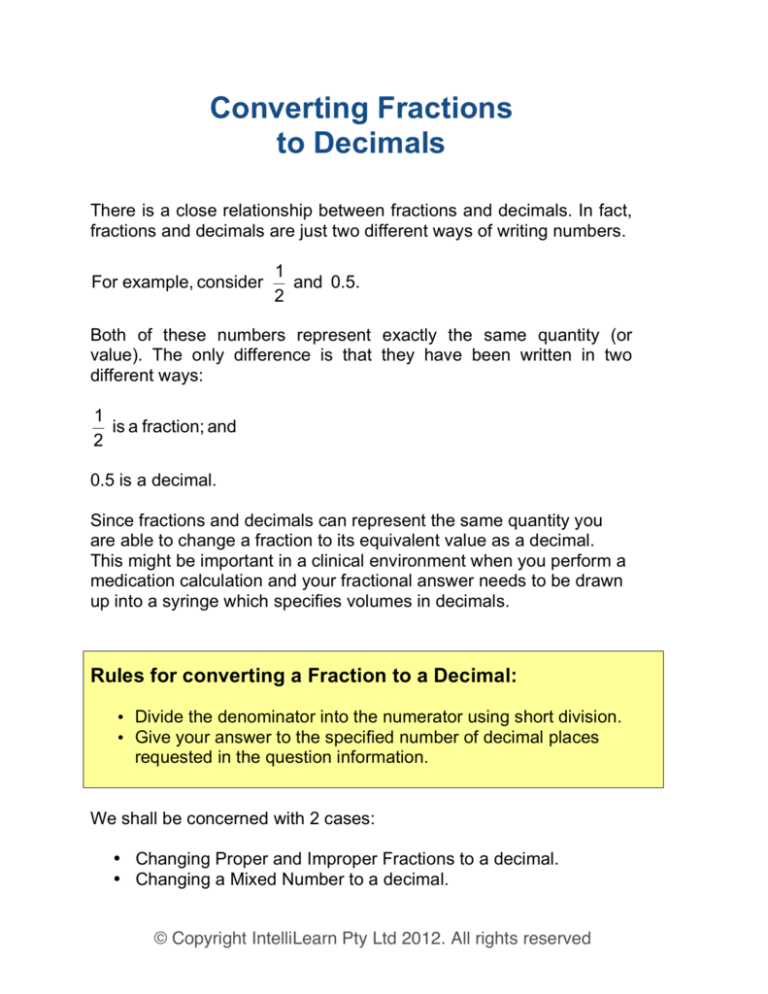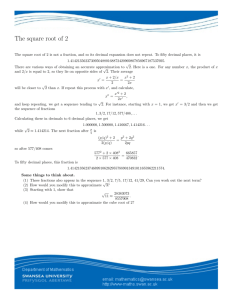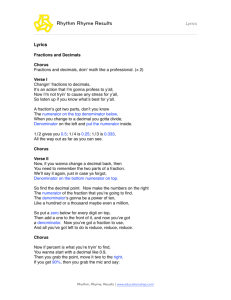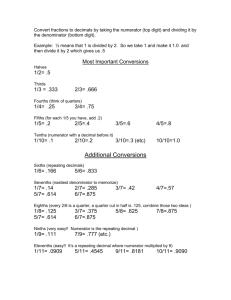
Converting Fractions
to Decimals
There is a close relationship between fractions and decimals. In fact,
fractions and decimals are just two different ways of writing numbers.
For example, consider
1
and 0.5.
2
Both of these numbers represent exactly the same quantity (or
value). The only difference is that they have been written in two
different ways:
1
is a fraction; and
2
0.5 is a decimal.
Since fractions and decimals can represent the same quantity you
are able to change a fraction to its equivalent value as a decimal.
This might be important in a clinical environment when you perform a
medication calculation and your fractional answer needs to be drawn
up into a syringe which specifies volumes in decimals.
Rules for converting a Fraction to a Decimal:
• Divide the denominator into the numerator using short division.
• Give your answer to the specified number of decimal places
requested in the question information.
We shall be concerned with 2 cases:
• Changing Proper and Improper Fractions to a decimal.
• Changing a Mixed Number to a decimal.
© Copyright IntelliLearn Pty Ltd 2012. All rights reserved
Converting Proper and Improper Fractions
to Decimals
Recall that Proper and Improper Fractions are fractions do not have a
whole number at the front.
To convert an Improper or Proper Fraction to a decimal you must
divide the numerator (the top number) by the denominator (the
bottom number) using short division. That is:
Numerator ÷ Denominator
Another way to say this is: ‘The top number divided by the bottom
number using short division’.
In order to carry this out, skills in short division and rounding are
critical. If you do not feel confident with short division and rounding it
is essential that you review these sections of theory before
continuing.
Example
A patient is taking
1.
3
of a tablet daily. Write this fraction as a decimal.
4
Divide the numerator by the denominator using short
division. The answer will be the value of that original
fraction expressed as a decimal:
3
=3÷4
4
(Top number divided by the bottom number)
Write this fraction in short division notation like this:
0. 7 5
4 3.3 0 2 0
© Copyright IntelliLearn Pty Ltd 2012. All rights reserved
and so
3
= 0.75
4
(Expressed as a decimal)
Example
Change
1.
4
to a decimal and express the answer to 3 decimal places.
7
Start by dividing the numerator by the denominator using short
division:
4
= 4÷7
7
(Top number divided by the bottom number)
Write this in short division notation like this:
0. 5 7 1 4
7 4.4 0 5 01 0 3 0
= 0.5714
and so
4
= 0.571
7
(Expressed to 3 decimal places)
Example
Write
1.
1
correct to 2 decimal places.
3
Divide the numerator by the denominator using short division:
1
= 1÷ 3
3
(Top number divided by the bottom number)
Write this in short division notation like this:
© Copyright IntelliLearn Pty Ltd 2012. All rights reserved
0. 3 3 3
3 1.1 01 01 0
= 0.333
and so
1
= 0.33
3
(Expressed to 2 decimal places)
Converting Mixed Numbers
to Decimals
Recall that Mixed Numbers are fractions that have a whole number at
the front. They represent a quantity larger than one whole and
therefore our final decimal answer must also be larger than one
whole.
To change a Mixed Number to a decimal you should first change the
Mixed Number to an Improper Fraction and then divide the numerator
(the top number) by the denominator (bottom number) exactly as you
did for Proper and Improper Fractions. That is:
Numerator ÷ Denominator
Example
Change 2
1.
2
to a decimal and express your answer to 3 decimal places.
3
You must first change the Mixed Number to an Improper
Fraction:
2
2 8
=
3 3
© Copyright IntelliLearn Pty Ltd 2012. All rights reserved
2.
Now divide the numerator by the denominator using short
division:
8
= 8÷3
3
(Top number divided by the bottom number)
Write this in short division notation like this:
2. 6 6 6 6
3 8. 2 0 2 0 2 0 2 0
= 2.6666…
and so
8
= 2.667
3
(Expressed to 3 decimal places)
Example
Change 4
1.
Change the Mixed Number to an Improper Fraction:
4
2.
3
to a decimal and express your answer to 2 decimal places.
4
3 19
=
4
4
Divide the numerator by the denominator (top number divided
by the bottom number) using short division:
19
= 19 ÷ 4
4
Write this in short division notation like this:
© Copyright IntelliLearn Pty Ltd 2012. All rights reserved
0 4. 7 5
4 11 9.3 0 2 0
= 4.75
and so
19
= 4.75
4
(Expressed to 2 decimal places)
© Copyright IntelliLearn Pty Ltd 2012. All rights reserved





